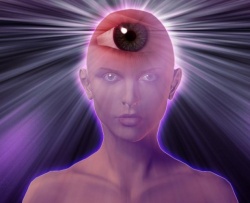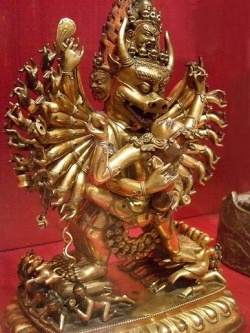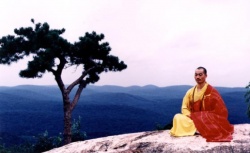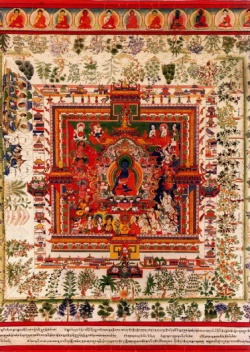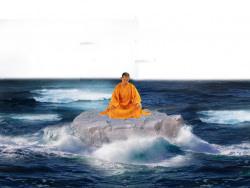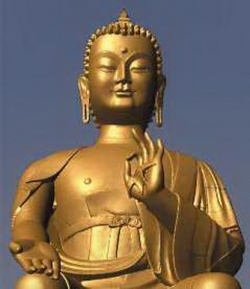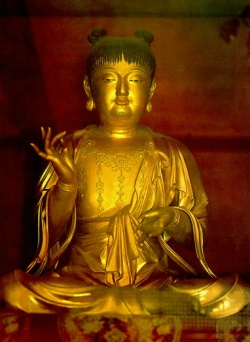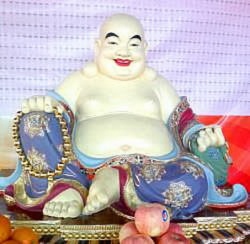Buddhist beliefs
by Jeffrey Hays
Buddhists believe that life is full of misery and is ultimately is unreal. The cycle of birth and rebirth continues because of attachment and desire to the "unreal self." Meditation and good deeds, it is thought, will ultimately end the cycle and help the individual to achieve Nirvana, a state of blissful nothingness. To achieve this one must look inward and gain control of the mind and find internal peace. To achieve this takes time and is an evolutionary process that takes place in stages through many lifetimes and cycles or birth, death and rebirth to attain the "real soul" within a person which is in a constant state of flux.
Buddhists believe that the only thing that matters is the inward self; that the goal of Buddhism is to reach a state of nothingness; and human beings are compositions of five temporary states—physical form, sensation, perception, volition and consciousness—all of which disappear after death. Buddhist deny the existence of an individual soul and tell their followers they must transcend this egocentric view to reach nirvana. In its purist forms, Buddhism has no beginning and no end, no Creation and no Heaven and no soul. For this reason has Buddhism has been called a religion without God.
Buddhists believe: 1) life is full of suffering, death, sickness and the loss of loved ones; 2) life is perpetuated by reincarnation (rebirth); 3) suffering is caused by desire (particularly physical desire and the desire for personal fulfillment) and liberation from rebirth occurs with the elimination of desire; 4) eight steps ("The Eightfold Path") are necessary to live a good life on earth; 5) the only one way to escape suffering is the way of Buddha; 6) this path leads to nirvana; and 7) salvation comes with faith in Buddha and practice of Buddha law ( Dharma ) as preached by a community of monks (the Sangha).
There are many aspects of Buddhism that simply seem to be beyond expression. The religious historian I.B. Hunter described Buddhism as a religion of “affinities, depths, heights and subtleties, with its solidarity and cohesiveness, its clear pointing to something more than could be actually said in words.”
Some view Buddhism as benevolent but ineffectual, pointing out that Buddhist intellectuals supported Japan’s militarist before World War II and supported the Sinhalese in their violent civil war in Sri Lanka against the Tamils. Describing the appeal of Buddhism to its early adherents Nietzsche wrote of “races grown kindly, gentle, overintellectual who feel pain too easily.”
Websites and Resources: Buddha Net buddhanet.net/e-learning/basic-guide ; Victoria and Albert Museum vam.ac.uk/collections/asia/asia_features/buddhism/index ; Religious Tolerance Page religioustolerance.org/buddhism ; Wikipedia article Wikipedia ; Internet Sacred Texts Archive sacred-texts.com/bud/index ; Introduction to Buddhism webspace.ship.edu/cgboer/buddhaintro ;
Books: Buddhism by Christmas Humphrey (Pelican); Buddhism Explained by Phra Khantipalo; Buddhist Dictionary by Mahathera Nyanatiloka; Siddhartha by Herman Hesse. Also recommended are books by the Dalai Lama, Robert Thurman, a respected Buddhist scholar and former Tibetan Buddhist monk; and Thich Nhat Hanh, a Buddhist monk from Vietnam who has been involved with various anti-war activities. Film: Little Buddha
Websites and Resources on Buddhist Art: buddhism.org/board/main.cgi?board=BuddhistArt ; Buddhist Images buddhistimages.co.uk ; Religion Facts Images religionfacts.com/buddhism/gallery ; Buddhist Symbols viewonbuddhism.org/general_symbols_buddhism ; Buddhist Artwork buddhanet.net/budart/index ; Buddhism Images freewebs.com/buddhaimages ; Wikipedia article on Buddhist Art Wikipedia ; Buddha Images http://www.buddha-images.com/ ; Buddhist Art artlex.com/ArtLex/b/Buddhism ; Huntington Archives Buddhist Art kaladarshan.arts.ohio-state.edu ; Buddhist Art Resources academicinfo.net/buddhismart
Dharma, Buddhist Teaching
Dharma, or “what is right and what ought to be,” is Buddha’s teachings. The statements that The Buddha is recorded of having said were generally very brief. He only elaborated upon them if requested to or he viewed such elaborations were necessary. These statements were comprehended in many different ways by many different individuals and thousands of pages were written about them.
The Buddha’s teaching was not designed to answer philosophical or speculative questions. It was established to offer a means of escape from suffering. Gautama Buddha was put off by speculation about the cosmos and eternity and was interested mostly in what could help one reach enlightenment in the here and now. Buddhism philosophy and cosmology is either rooted in Hinduism or came about as Buddhism developed after Gautama’s death.
On one hand The Buddha encouraged individuals to seek their own inner truths and never said that his teachings and doctrines were sacrosanct and should be followed completely. But on the other hand he said that there was one sole Way to achieve purification and overcome suffering and those who deviated from the Way would some how fall short of achieving his aim.
In Dhammapada 276 The Buddha said: “Sadly lives the man of sloth involved in evil unskilled states of mind, and great is the goal he fails to win. But he who stirs up energy lives happily, aloof from unskilled states of mind and great is the goal he makes perfect. Not through what is low comes the attainment of the highest, but through what is high come the attainment of the highest.”
The Way and the Four Holy Truths
Buddha's teachings are known as "The Way," "The Path" or the “Middle Way.” The Buddhist "Path" consists of three directions— morality, meditation and wisdom—all of which are pursued simultaneously. The "Middle Way" refers to a life is halfway between a life of self-torture and asceticism and a life of self-indulgence in the material world.
According to the Middle Way one must: 1) live their life “fully but not care what happens; " 2) avoid putting too much emphasis on material success because "it soon turns to dust in our hands;" 3) don’t get “obsessed with the dust, convinced that nothing matters”; and 4) recognize the Four Noble Truths.
The Four Holy Truths of Buddhism are: 1) dukka, the belief that human life is an exercise in suffering replete with evil, disease, imperfection and unhappiness; 2) samodaya , the concept that suffering is caused by craving and desire, which can not satisfy the spirit; 3) nirodha , freedom offered by renouncement of desire, which is rooted in ignorance; and 4) magga , the cessation of desire which culminates in nirvana by following the Eightfold Path. These principals were introduced in the First Sermon at Sarnath.
Three Jewels and the Eightfold Path
Baby Buddha The Three Jewels—The Buddha, Dharma (The Buddha's teachings), and the Sangha (the community of monks) who preserve and transmit Buddha’s teachings—are central to the understanding and teaching of Buddhism and are the Buddhist equivalent of the Christian Holy Trinity. One definition of a Buddhist is one “one who takes refuge in the Three Jewels.” The vow taken by Theravada monks—"I take refuge in the Buddha, I take refuge in the law, I take refuge in the Sangha—is asserts their embrace of the Three Jewels.
The "Eightfold Path," which Buddhists are supposed to follow is comprised of: 1) right understanding (the realization that is full of suffering and suffering is caused by desire); 2) right thought (conditioning the mind to be free of desire and ill thoughts towards others); 3) right speech (refraining from lies, abuse and deceit); 4) right bodily action (refraining from violence); 5) right livelihood (avoiding self-indulgence); 6) right moral effort (showing kindness and controlling passions); 7) right mindedness (developing virtues); and 8) right concentration (practicing meditation).
The "Eightfold Path” is not only seen as a code conduct but also as means of achieving nirvana by overcoming the senses and consciousness in a step-by-step way progressing through the Three Pillars of the Eightfold Path: 1) wisdom ( panna , which embraces one and two in the Eightfold Path; 2) morality ( sila , which embraces three, four and five); and 3) concentration ( samadhi , which embraces six, seven and eight).
Buddhism, Impermanence and Illusion
three baskets texts Buddhists believe there is no permanence; all things are ultimately illusions and there are only sequences of appearances that appear as reality. Death represents the trading of old appearances for new ones. Even gods are only temporary forms of appearance.
The belief that the world is not real but is a world of illusion lies at the heart of Mahayana Buddhist thought. Religious scholar Edward Conze wrote: “In actual reality there are no Buddhas, no Bodhisattvas, no perfections, no stages and no paradise—none of all this. All these conceptions have no reference to anything that is actually there. They are just expedients, concessions of the multitude of ignorant, provisional constructs of thought, which become superfluous after having served their purpose.”
“Nirvana, as the true Reality, is one single and has no second. All multiplicity, all separation, all duality is a sign of falseness. Everything apart from the One, also called ‘Emptiness’ or ‘Suchness’ is devoid of real existence.”
True understanding of this reality is extremely subtle and abstruse and is said to take not just many years but many lifetimes to comprehend. According to the Perfect Wisdom sutra: “No one can grasp the perfection of wisdom, for no Dharma at all has been indicated, lit up or communicated. So there will be on one who can even grasp it.” Those taken into the consciousness of the gods found: “There is nothing at all to be understood! For nothing in particular has been indicated, nothing in particular has been explained.”
In a letter to National Geographic, San-Diego-resident Tim Cardoza wrote, “Enlightenment is not a permanent state to be achieved in the future. It happens in the present moment, breath by breath. The concept of a permanent state of enlightenment is the big romantic sham of Buddhism. I fell for it. It is a useful sham, though. Once the practice is started, it’s difficult to quit.”
Emptiness, Wisdom and Mahayana Buddhism
Mahayana Buddhism is very much preoccupied with the idea of “Emptiness”—which one scholar described as “absolute transcendental reality beyond the grasp of intellectual comprehension and verbal expression”—and reaching an “empty” selfless state by purging oneself of one’s self through self-sacrifice, service, insight and wisdom to penetrate to true reality or the “own-being” of things
Conze, wrote: “The perfection of wisdom finally is the ability to understand the essential properties of all processes and phenomena, their mutual relations, the conditions which bring about their rise and fall, and the ultimate unreality of their environmental existence. At the highest point it leads right into the Emptiness which is the one and only reality.”
The primary ontological beliefs in Mahayana Buddhism are :1) Thought in its natural state of “own-being” is perfectly pure and translucent; 2) empirical knowledge is regarded with suspicion and, in the view of some, is factitious; 3) all things are “empty”; 4) Emptiness expressed as “Suchness” or “one,” implies meaning that alone is real and absolute; 5) if all is the same then absolute and relative; conditional and unconditional; true and false ; and yes and no are all the same. With ths being the case self-contradictory statements are often closest to the true reality.
Buddhist Philosophizing
Perry Garfinkel wrote in National Geographic: “Some people argue that the Buddha was right, that Buddhism should not be categorized as a religion but as a philosophy or form of psychology. After all, unlike other religions, there is no supreme being, and it encourages you to question—even challenge—authority. [Source: Perry Garfinkel, National Geographic, December 2005]
Buddhists believe you shouldn’t delve too deeply into the past, speculating about the future is pointless and the present should be experienced as a state of being rather than analyzed. Thich Nhat Hanh, a Buddhist monk who was exiled from Vietnam in the 1960s for his nonviolent antiwar activities, told National Geographic, “It all starts with a spin on an old adage: ‘Don't just do something, sit there...First you must learn what the Buddha learned, to still the mind. Then you don't take action; action takes you." [Ibid]
Philosophical discussions are especially important with Mahayana Buddhists. Monks engage in long philosophical discussions about thing like “What is change?” and “What is right?” Novice monks learn the subtle points of Buddhist theology by participating in debates on things like whether or not a rabbit has a horn and whether or not past and future events can be described as real.
Some say Buddhism is more a science of the mind than a religion. Describing the Buddhist form of discussion, one American Buddhist told the New Yorker, “The philosophy of the mind” was presented as “a kind of brick-by-brick construction of proper view of consciousness. Each point was introduced, examined from the point of view of several different schools of Buddhist thought, then synthesized into a conclusion that led to the next point.”
Interdependence—the idea that all beings are linked together in a network known as Indra’s Net—is a key concept in Buddhist. Alan Wallace of the Interdisciplinary Study of Consciousness told Smithsonian magazine, “The pursuit of knowledge in Buddhism in inextricably related to the pursuit of virtue, and the pursuit of virtue is inextricably related to the pursuit of happiness.
Buddhist Dependent Organization
“Dependent Organization,” also known as the “Chain of Causation” or “Conditions Arising,” is a central theme in Buddhist philosophy. It is a 12-linked chain that explains how things are connected and attachments leads to problems. If the chain is unraveled nirvana is attained. While The Buddha sat under the Bodhi he came to the realization that: “He who sees dependent organization see Dharma. He who sees Dharma sees dependent organization.”
Hunter defines dependent organization “an abstract law of continency denying independent existence to finite thing, though not denying their total reality. Such reality as they have is conditional on occurrence of something else that has already taken place and is conditioned by it.”
Dependent organization operates in three modes within the context of karma and reincarnation: 1) the Past (conditioned by karmic formation or ignorance of karmic formations); 2) the Present (conditioned by consciousness defined by names and shapes; names and shapes detected with the senses; the impact of the senses on feelings; the relationship between feelings and cravings, grasping and becoming); and 3) the Future (conditioned by rebirth, living and dying).
Implied in this construct is that transcendence can be achieved by overcoming each stage in a kind of step by step progression with the understanding that if one stage can be overcome the stages before can also be overcome.
Buddhism and Miracles
the Buddha performed miracles that won him admirers but he warned his disciples not to show off their powers Kenneth Woodward wrote in Newsweek: Both Hinduism and Buddhism are quite precise about the kinds of powers or "superknowledges" that a successful practitioner of meditation can expect. Among them are knowledge of one's previous lives, and the abilities to traverse great distances in a moment and to penetrate the minds of others. But Buddhist sages, in particular, are wary of displaying these powers to others, lest it bolster the ego they are trying to overcome. Venerable Master Hsuan Hua, a Chinese Buddhist monk, established a Chan monastery in San Francisco in 1970. In Asia, it is reported that he could heal the ailments of those willing to follow the dharma of the Buddha. But in the United States, where he died in 1995, Master Hua thought that using supernatural powers as a teaching tool would be counterproductive in a rational, scientific society.” However “the "modern" shrine tradition may well have begun 2,500 years ago, when the bones of the deceased Buddha were distributed as relics to tribal chieftains. Later they were collected and enshrined in stupas across northern India. [Source: Kenneth Woodward, Newsweek, April 30, 2000]\ Reporting from Bara, Nepal, Raekha Prasad wrote in the Times of London: “Some closed their eyes and clasped their hands in prayer, others knelt and touched their foreheads to the cool earth beneath a canopy of trees deep in the forest of southern Nepal. By early morning hundreds of people had already reached this hidden spot at the end of a mist-shrouded mud track. All had come to see the teenage boy they believe to be a reincarnation of Buddha, sitting silently beneath a peepul tree. [Source: Raekha Prasad, The Times, December 5, 2005]
“Since word spread that Ram Bahadur Bamjan, the 16-year-old son of a maize farmer in a nearby village, has not eaten or drunk in the six months that he has been meditating in the lotus position, tens of thousands of devotees from across Nepal and India have flocked to Char Koshe jungle to worship him. The teenager sat in an alcove of exposed peepul roots. His closed eyes were framed by a messy mop of hair, and a brown robe draped over one shoulder exposed his right arm and hand. [Ibid]
“Having heard that early morning was the time to witness light emanating from the boy’s brow and hand, the pilgrims had set off before dawn to walk miles over a rocky path before removing their shoes and shuffling in a snaking crowd to a fence strewn with marigolds, candles and burning incense. Around the enclosure, local people touted picture postcards, booklets and CDs telling the story of the boy’s life. Makeshift food and tea stalls run by villagers had sprung up. Allowed no closer to Ram Bamjan than 50 metres after concerns that the huge crowds were disturbing his concentration, the devotees stood on tip-toe, craning their necks to catch a glimpse of the distant figure.
“I saw a reddish-yellow light on his forehead. A few minutes later I saw it on his hand. It’s real. I’ve never seen anything like it,” Dhanbaha Durgurung, 60, a retired Gurkha in the British Army, said. He had made the ten-hour journey from his home in Pokhara, in central Nepal, after hearing a BBC radio report about the boy. “I had to see it for myself,” he said. “ I believe he’s the reincarnation of Buddha. I’m going to come back in a week and bring my whole family.” The spectacle resembles an episode in the life of Buddha, who found enlightenment more than 2,500 years ago after 49 days under a peepul tree. He was born only 257km (160 miles) from Bara in 540BC. [Ibid]
In the nearby village of Ratanpur, Maya Devi, 50, the mother of Ram Bamjan, said that her son had changed after spending almost two years in Buddhist monasteries in India, including Bodh Gaya, the spot in the state of Bihar where Buddha gained enlightenment. “He had always been a loner, but when he returned from India he just stayed at home and would chant and study Buddhist scripts,” she said, opening a cupboard in her son’s sparse bedroom that was filled with his red, satin-bound religious books.
Maya Devi was sad to see the sixth of her nine children go. He did not tell his family that he planned to live in the forest and crept out during the night to avoid being followed. She said: “I didn’t want him to stay away from home at night in the jungle. It’s a dangerous place. If he had not been called there by God, he would not have survived for so long.” Villagers say that last month Ram shook off the effects of a poisonous snake bite. He apparently told an older brother that he did not want to be followed into the forest and that he was not a Buddha. He said: “I’ve got my education directly from God, but what I’ve learnt I’m not revealing now. I need six years of meditation.”
Local officials have asked scientific and religious bodies in Nepal to investigate whether the claims about the boy are true. In particular they want to know what happens when a curtain screens the boy from observers at night. There have been suggestions that the boy is part of a plot by left-wing guerrillas to collect money from gullible villagers, but officials are hampered by a group of minders who refuse to allow anyone to disturb him. Santa Raj Subedi, the chief government official in Bara, said: “The strength of religious belief means our hands are tied. We can’t just march in and interfere. Besides, being able to meditate is a human right. We can’t stop anyone doing it.” Maya Devi is undecided about whether her son is the reincarnation of Buddha. “He’s certainly extraordinary,” she said. “But I’ll wait until after his six years of meditation to decide whether he’s a god.”
Text Sources: World Religions edited by Geoffrey Parrinder (Facts on File Publications, New York); Encyclopedia of the World’s Religions edited by R.C. Zaehner (Barnes & Noble Books, 1959); Encyclopedia of the World Cultures edited by David Levinson (G.K. Hall & Company, New York, 1994); The Creators by Daniel Boorstin National Geographic articles. Also the New York Times, Washington Post, Los Angeles Times, Smithsonian magazine, Times of London, The New Yorker, Time, Newsweek, Reuters, AP, AFP, Lonely Planet Guides, Compton’s Encyclopedia and various books and other publications.
